Impact of Entrepreneurial Ecosystem Discussions in Smart Cities: Comprehensive Assessment of Social Media Data
Abstract
1. Introduction
- Can SNS analytics measure the entrepreneurial ecosystem activities within cities? A methodological approach to utilizing SNSs data to identify the presence of impactful entrepreneurial discussion.
- From the standpoint of the impact of SNSs on smart cities, what type of content in SNSs is more influential regarding innovation and entrepreneurial ecosystem discussions?
2. Background
2.1. Definition of Smart Cities
2.2. The Role of Social Network Services (SNSs) in Innovation and Entrepreneurial Ecosystems
3. Research Methodology
4. Evaluating Entrepreneurial Ecosystem Activity on Twitter: London City Case Experiment
4.1. Data Collection
4.2. Curate
5. Results and Findings
5.1. Content Type Categorization
5.2. Content Type Impression in SNSs
6. Discussion and Conclusions
7. Limitations and Future Research
Funding
Conflicts of Interest
Appendix A
| Mean | Std. Deviation | N | |
|---|---|---|---|
| interact | 12.66 | 12.079 | 168 |
| ed-pers | 0.08 | 0.268 | 168 |
| ed-prof | 0.05 | 0.226 | 168 |
| ed-corp | 0.05 | 0.214 | 168 |
| mot-pers | 0.07 | 0.248 | 168 |
| mot-prof | 0.07 | 0.248 | 168 |
| mot-corp | 0.05 | 0.214 | 168 |
| pro-pers | 0.03 | 0.170 | 168 |
| pro-prof | 0.03 | 0.170 | 168 |
| pro-corp | 0.08 | 0.268 | 168 |
| new-pers | 0.05 | 0.214 | 168 |
| new-prof | 0.08 | 0.268 | 168 |
| new-corp | 0.05 | 0.226 | 168 |
| interact | ed-pers | ed-prof | ed-corp | mot-pers | mot-prof | mot-corp | pro-pers | pro-prof | pro-corp | new-pers | new-prof | new-corp | ||
|---|---|---|---|---|---|---|---|---|---|---|---|---|---|---|
| Pearson Correlation | interact | 1.000 | −0.208 | 0.237 | −0.017 | 0.191 | 0.415 | −0.003 | −0.117 | −0.097 | −0.112 | −0.142 | −0.097 | 0.127 |
| ed-pers | −0.208 | 1.000 | −0.069 | −0.065 | −0.077 | −0.077 | −0.065 | −0.051 | −0.051 | −0.084 | −0.065 | −0.084 | −0.069 | |
| ed-prof | 0.237 | −0.069 | 1.000 | −0.053 | −0.063 | −0.063 | −0.053 | −0.042 | −0.042 | −0.069 | −0.053 | −0.069 | −0.057 | |
| ed-corp | −0.017 | −0.065 | −0.053 | 1.000 | −0.059 | −0.059 | −0.050 | −0.039 | −0.039 | −0.065 | −0.050 | −0.065 | −0.053 | |
| mot-pers | 0.191 | −0.077 | −0.063 | −0.059 | 1.000 | −0.070 | −0.059 | −0.046 | −0.046 | −0.077 | −0.059 | −0.077 | −0.063 | |
| mot-prof | 0.415 | −0.077 | −0.063 | −0.059 | −0.070 | 1.000 | −0.059 | −0.046 | −0.046 | −0.077 | −0.059 | −0.077 | −0.063 | |
| mot-corp | −0.003 | −0.065 | −0.053 | −0.050 | −0.059 | −0.059 | 1.000 | −0.039 | −0.039 | −0.065 | −0.050 | −0.065 | −0.053 | |
| pro-pers | −0.117 | −0.051 | −0.042 | −0.039 | −0.046 | −0.046 | −0.039 | 1.000 | −0.031 | −0.051 | −0.039 | −0.051 | −0.042 | |
| pro-prof | −0.097 | −0.051 | −0.042 | −0.039 | −0.046 | −0.046 | −0.039 | −0.031 | 1.000 | −0.051 | −0.039 | −0.051 | −0.042 | |
| pro-corp | −0.112 | −0.084 | −0.069 | −0.065 | −0.077 | −0.077 | −0.065 | −0.051 | −0.051 | 1.000 | −0.065 | −0.084 | −0.069 | |
| new-pers | −0.142 | −0.065 | −0.053 | −0.050 | −0.059 | −0.059 | −0.050 | −0.039 | −0.039 | −0.065 | 1.000 | −0.065 | −0.053 | |
| new-prof | −0.097 | −0.084 | −0.069 | −0.065 | −0.077 | −0.077 | −0.065 | −0.051 | −0.051 | −0.084 | −0.065 | 1.000 | −0.069 | |
| new-corp | 0.127 | −0.069 | −0.057 | −0.053 | −0.063 | −0.063 | −0.053 | −0.042 | −0.042 | −0.069 | −0.053 | −0.069 | 1.000 | |
| Sig. (1-tailed) | interact | 0.003 | 0.001 | 0.414 | 0.006 | 0.000 | 0.485 | 0.065 | 0.106 | 0.074 | 0.033 | 0.105 | 0.050 | |
| ed-pers | 0.003 | 0.187 | 0.202 | 0.162 | 0.162 | 0.202 | 0.257 | 0.257 | 0.140 | 0.202 | 0.140 | 0.187 | ||
| ed-prof | 0.001 | 0.187 | 0.247 | 0.209 | 0.209 | 0.247 | 0.296 | 0.296 | 0.187 | 0.247 | 0.187 | 0.233 | ||
| ed-corp | 0.414 | 0.202 | 0.247 | 0.223 | 0.223 | 0.260 | 0.307 | 0.307 | 0.202 | 0.260 | 0.202 | 0.247 | ||
| mot-pers | 0.006 | 0.162 | 0.209 | 0.223 | 0.183 | 0.223 | 0.275 | 0.275 | 0.162 | 0.223 | 0.162 | 0.209 | ||
| mot-prof | 0.000 | 0.162 | 0.209 | 0.223 | 0.183 | 0.223 | 0.275 | 0.275 | 0.162 | 0.223 | 0.162 | 0.209 | ||
| mot-corp | 0.485 | 0.202 | 0.247 | 0.260 | 0.223 | 0.223 | 0.307 | 0.307 | 0.202 | 0.260 | 0.202 | 0.247 | ||
| pro-pers | 0.065 | 0.257 | 0.296 | 0.307 | 0.275 | 0.275 | 0.307 | 0.347 | 0.257 | 0.307 | 0.257 | 0.296 | ||
| pro-prof | 0.106 | 0.257 | 0.296 | 0.307 | 0.275 | 0.275 | 0.307 | 0.347 | 0.257 | 0.307 | 0.257 | 0.296 | ||
| pro-corp | 0.074 | 0.140 | 0.187 | 0.202 | 0.162 | 0.162 | 0.202 | 0.257 | 0.257 | 0.202 | 0.140 | 0.187 | ||
| new-pers | 0.033 | 0.202 | 0.247 | 0.260 | 0.223 | 0.223 | 0.260 | 0.307 | 0.307 | 0.202 | 0.202 | 0.247 | ||
| new-prof | 0.105 | 0.140 | 0.187 | 0.202 | 0.162 | 0.162 | 0.202 | 0.257 | 0.257 | 0.140 | 0.202 | 0.187 | ||
| new-corp | 0.050 | 0.187 | 0.233 | 0.247 | 0.209 | 0.209 | 0.247 | 0.296 | 0.296 | 0.187 | 0.247 | 0.187 | ||
| N | interact | 168 | 168 | 168 | 168 | 168 | 168 | 168 | 168 | 168 | 168 | 168 | 168 | 168 |
| ed-pers | 168 | 168 | 168 | 168 | 168 | 168 | 168 | 168 | 168 | 168 | 168 | 168 | 168 | |
| ed-prof | 168 | 168 | 168 | 168 | 168 | 168 | 168 | 168 | 168 | 168 | 168 | 168 | 168 | |
| ed-corp | 168 | 168 | 168 | 168 | 168 | 168 | 168 | 168 | 168 | 168 | 168 | 168 | 168 | |
| mot-pers | 168 | 168 | 168 | 168 | 168 | 168 | 168 | 168 | 168 | 168 | 168 | 168 | 168 | |
| mot-prof | 168 | 168 | 168 | 168 | 168 | 168 | 168 | 168 | 168 | 168 | 168 | 168 | 168 | |
| mot-corp | 168 | 168 | 168 | 168 | 168 | 168 | 168 | 168 | 168 | 168 | 168 | 168 | 168 | |
| pro-pers | 168 | 168 | 168 | 168 | 168 | 168 | 168 | 168 | 168 | 168 | 168 | 168 | 168 | |
| pro-prof | 168 | 168 | 168 | 168 | 168 | 168 | 168 | 168 | 168 | 168 | 168 | 168 | 168 | |
| pro-corp | 168 | 168 | 168 | 168 | 168 | 168 | 168 | 168 | 168 | 168 | 168 | 168 | 168 | |
| new-pers | 168 | 168 | 168 | 168 | 168 | 168 | 168 | 168 | 168 | 168 | 168 | 168 | 168 | |
| new-prof | 168 | 168 | 168 | 168 | 168 | 168 | 168 | 168 | 168 | 168 | 168 | 168 | 168 | |
| new-corp | 168 | 168 | 168 | 168 | 168 | 168 | 168 | 168 | 168 | 168 | 168 | 168 | 168 |
| Model | Variables Entered | Variables Removed | Method |
|---|---|---|---|
| 1 | new-corp, pro-prof, pro-pers, mot-corp, ed-corp, new-pers, ed-prof, mot-prof, mot-pers, ed-pers, new-prof, pro-corp a | Enter |
| Model | R | R Square | Adjusted R Square | Std. Error of the Estimate | Durbin-Watson |
|---|---|---|---|---|---|
| 1 | 0.611 a | 0.374 | 0.325 | 9.922 | 1.556 |
| Model | Unstandardized Coefficients | Standardized Coefficients | t | Sig. | 95,0% Confidence Interval for B | Correlations | Collinearity Statistics | ||||||
|---|---|---|---|---|---|---|---|---|---|---|---|---|---|
| B | Std. Error | Beta | Lower Bound | Upper Bound | Zero-order | Partial | Part | Tolerance | VIF | ||||
| 1 | (Constant) | 10.836 | 1.338 | 8.100 | 0.000 | 8.194 | 13.479 | ||||||
| ed-pers | −6.836 | 3.060 | −0.152 | −2.234 | 0.027 | −12.881 | −0.792 | −0.208 | −0.177 | −0.142 | 0.877 | 1.141 | |
| ed-prof | 13.830 | 3.568 | 0.259 | 3.877 | 0.000 | 6.783 | 20.878 | 0.237 | 0.297 | 0.246 | 0.908 | 1.101 | |
| ed-corp | 0.914 | 3.754 | 0.016 | 0.243 | 0.808 | −6.503 | 8.330 | −0.017 | 0.020 | 0.015 | 0.917 | 1.091 | |
| mot-pers | 10.527 | 3.277 | 0.216 | 3.212 | 0.002 | 4.054 | 17.001 | 0.191 | 0.250 | 0.204 | 0.892 | 1.121 | |
| mot-prof | 20.709 | 3.277 | 0.425 | 6.319 | 0.000 | 14.235 | 27.183 | 0.415 | 0.453 | 0.402 | 0.892 | 1.121 | |
| mot-corp | 1.664 | 3.754 | 0.029 | 0.443 | 0.658 | −5.753 | 9.080 | −0.003 | 0.036 | 0.028 | 0.917 | 1.091 | |
| pro-pers | −6.236 | 4.635 | −0.088 | −1.346 | 0.180 | −15.392 | 2.919 | −0.117 | −0.107 | −0.086 | 0.945 | 1.058 | |
| pro-prof | −4.836 | 4.635 | −0.068 | −1.044 | 0.298 | −13.992 | 4.319 | −0.097 | −0.084 | −0.066 | 0.945 | 1.058 | |
| pro-corp | −2.836 | 3.060 | −0.063 | −0.927 | 0.355 | −8.881 | 3.208 | −0.112 | −0.074 | −0.059 | 0.877 | 1.141 | |
| new-pers | −5.836 | 3.754 | −0.103 | −1.555 | 0.122 | −13.253 | 1.580 | −0.142 | −0.124 | −0.099 | 0.917 | 1.091 | |
| new-prof | −2.221 | 3.060 | −0.049 | −0.726 | 0.469 | −8.265 | 3.823 | −0.097 | −0.058 | −0.046 | 0.877 | 1.141 | |
| new-corp | 8.275 | 3.568 | 0.155 | 2.319 | 0.022 | 1.227 | 15,322 | 0.127 | 0.183 | 0.147 | 0.908 | 1.101 | |
| Model | Dimension | Eigenvalue | Condition Index | Variance Proportions | ||||||||||||
|---|---|---|---|---|---|---|---|---|---|---|---|---|---|---|---|---|
| (Constant) | ed-pers | ed-prof | ed-corp | mot-pers | mot-prof | mot-corp | pro-pers | pro-prof | pro-corp | new-pers | new-prof | new-corp | ||||
| 1 | 1 | 1.820 | 1.000 | 0.09 | 0.03 | 0.02 | 0.02 | 0.02 | 0.02 | 0.02 | 0.01 | 0.01 | 0.03 | 0.02 | 0.03 | 0.02 |
| 2 | 1.000 | 1.349 | 0.00 | 0.04 | 0.01 | 0.00 | 0.08 | 0.02 | 0.22 | 0.16 | 0.01 | 0.04 | 0.07 | 0.20 | 0.00 | |
| 3 | 1.000 | 1.349 | 0.00 | 0.01 | 0.13 | 0.02 | 0.00 | 0.01 | 0.18 | 0.01 | 0.30 | 0.16 | 0.01 | 0.04 | 0.00 | |
| 4 | 1.000 | 1.349 | 0.00 | 0.21 | 0.01 | 0.07 | 0.06 | 0.21 | 0.02 | 0.21 | 0.00 | 0.05 | 0.01 | 0.01 | 0.00 | |
| 5 | 1.000 | 1.349 | 0.00 | 0.07 | 0.14 | 0.02 | 0.13 | 0.03 | 0.20 | 0.09 | 0.04 | 0.01 | 0.04 | 0.09 | 0.00 | |
| 6 | 1.000 | 1.349 | 0.00 | 0.02 | 0.00 | 0.01 | 0.00 | 0.02 | 0.02 | 0.00 | 0.00 | 0.01 | 0.00 | 0.00 | 0.77 | |
| 7 | 1.000 | 1.349 | 0.00 | 0.18 | 0.23 | 0.05 | 0.07 | 0.07 | 0.07 | 0.06 | 0.03 | 0.04 | 0.03 | 0.02 | 0.01 | |
| 8 | 1.000 | 1.349 | 0.00 | 0.00 | 0.00 | 0.00 | 0.06 | 0.04 | 0.02 | 0.02 | 0.06 | 0.26 | 0.09 | 0.28 | 0.00 | |
| 9 | 1.000 | 1.349 | 0.00 | 0.00 | 0.08 | 0.12 | 0.23 | 0.33 | 0.01 | 0.03 | 0.04 | 0.01 | 0.01 | 0.00 | 0.00 | |
| 10 | 1.000 | 1.349 | 0.00 | 0.05 | 0.06 | 0.27 | 0.01 | 0.03 | 0.05 | 0.02 | 0.07 | 0.04 | 0.24 | 0.03 | 0.00 | |
| 11 | 1.000 | 1.349 | 0.00 | 0.14 | 0.08 | 0.17 | 0.12 | 0.00 | 0.01 | 0.27 | 0.02 | 0.00 | 0.04 | 0.01 | 0.00 | |
| 12 | 1.000 | 1.349 | 0.00 | 0.00 | 0.04 | 0.08 | 0.00 | 0.00 | 0.03 | 0.02 | 0.31 | 0.11 | 0.25 | 0.03 | 0.00 | |
| 13 | 0.180 | 3.181 | 0.91 | 0.26 | 0.19 | 0.17 | 0.23 | 0.23 | 0.17 | 0.11 | 0.11 | 0.26 | 0.17 | 0.26 | 0.19 | |
| Minimum | Maximum | Mean | Std. Deviation | N | |
|---|---|---|---|---|---|
| Predicted Value | 4.00 | 31.55 | 12.66 | 7.384 | 168 |
| Std. Predicted Value | −1.173 | 2.558 | 0.000 | 1.000 | 168 |
| Standard Error of Predicted Value | 1.338 | 4.437 | 2.588 | 0.962 | 168 |
| Adjusted Predicted Value | 2.25 | 34.10 | 12.66 | 7.438 | 168 |
| Residual | −25.545 | 34.636 | 0.000 | 9.559 | 168 |
| Std. Residual | −2.575 | 3.491 | 0.000 | 0.963 | 168 |
| Stud. Residual | −2.700 | 3.661 | 0.000 | 1.002 | 168 |
| Deleted Residual | −28.100 | 38.100 | 0.000 | 10.346 | 168 |
| Stud. Deleted Residual | −2.757 | 3.818 | 0.003 | 1.015 | 168 |
| Mahal. Distance | 2.042 | 32.406 | 11.929 | 8.395 | 168 |
| Cook’s Distance | 0.000 | 0.103 | 0.006 | 0.015 | 168 |
| Centered Leverage Value | 0.012 | 0.194 | 0.071 | 0.050 | 168 |

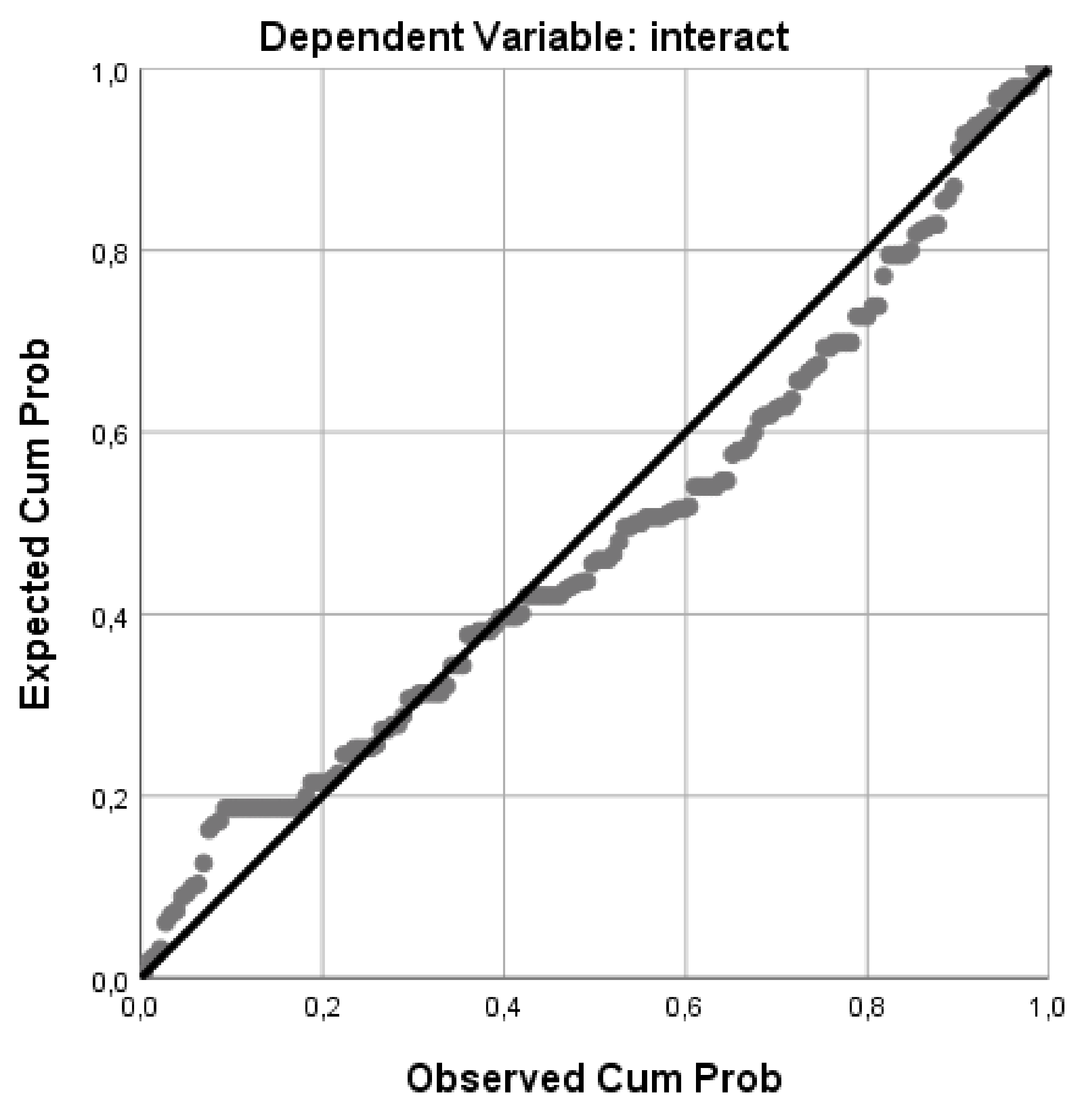
References
- Caird, S.; Hudson, L.; Kortuem, G. A Tale of Evaluation and Reporting in UK Smart Cities. 2016. Available online: http://oro.open.ac.uk/46008/7/__userdata_documents4_ctb44_Desktop_Tales_Smart_Cities_Final_2016.pdf (accessed on 25 February 2019).
- Bibri, S.E. A foundational framework for smart sustainable city development: Theoretical, disciplinary, and discursive dimensions and their synergies. Sustain. Cities Soc. 2018, 38, 758–794. [Google Scholar] [CrossRef]
- World Economic Forum. The Competitiveness of Cities: A report of the Global Agenda Council on Competitiveness. 2014. Available online: http://www3.weforum.org/docs/GAC/2014/WEF_GAC_CompetitivenessOfCities_Report_2014.pdf (accessed on 3 April 2019).
- Mori, K.; Christodoulou, A. Review of sustainability indices and indicators: Towards a new City Sustainability Index (CSI). Environ. Impact Assess. Rev. 2012, 32, 94–106. [Google Scholar] [CrossRef]
- Bibri, S.E.; Krogstie, J. Smart sustainable cities of the future: An extensive interdisciplinary literature review. Sustain. Cities Soc. 2017, 31, 183–212. [Google Scholar] [CrossRef]
- Albino, V.; Berardi, U.; Dangelico, R.M. Smart Cities: Definitions, Dimensions, Performance, and Initiatives. J. Urban. Technol. 2015, 22, 3–21. [Google Scholar] [CrossRef]
- Beattie, A. False Economy: A Surprising Economic History of the World; L. Penguin: London, UK, 2009. [Google Scholar] [CrossRef][Green Version]
- Anttiroiko, A.V. City-as-a-platform: The rise of participatory innovation platforms in finnish cities. Sustainability 2016, 8, 922. [Google Scholar] [CrossRef]
- Richter, C.; Kraus, S.; Syrjä, P. The Smart City as an opportunity for entrepreneurship. Int J. Entrep. Ventur. 2015, 7, 211. [Google Scholar]
- Lombardi, P.; Giordano, S.; Farouh, H.; Yousef, W. Modelling the smart city performance. Innovation 2012, 25, 137–149. [Google Scholar] [CrossRef]
- Hollands, R.G. Will the real smart city please stand up? City 2008, 12, 303–320. [Google Scholar] [CrossRef]
- Thuzar, M. Urbanization in Southeast Asia: Developing SMart Cities for the Future? Reg. Econ. Outlook 2012, 96–100. [Google Scholar]
- Kourtit, K.; Nijkamp, P. In praise of megacities in a global world. Reg. Sci. Policy Pract. 2013, 5, 167–182. [Google Scholar] [CrossRef]
- Caragliu, A.; del Bo, C.; Nijkamp, P. Smart cities in Europe. J. Urban. Technol. 2011, 18, 65–82. [Google Scholar] [CrossRef]
- Anthopoulos, L.G. Understanding Smart Cities: A Tool for Smart Government or an Industrial Trick? Springer International Publishing: Cham, Switzerland, 2017. [Google Scholar] [CrossRef]
- Zuccardi Merli, M.; Bonollo, E. Performance Measurement in the Smart Cities. In Smart City: How to create public and economic value with high technology in urban space; Springer: Cham, Switzerland, 2014; pp. 139–155. [Google Scholar]
- Wiebe, J.; Breck, E.; Buckley, C.; Cardie, C. Recognizing and Organizing Opinions Expressed in the World Press. In Working Notes - New Directions in Question Answering (AAAI Spring Symposium Series US. 2003, pp. 12–19. Available online: https://www.cs.cornell.edu/home/cardie/papers/aaai-ss-overall-03.pdf (accessed on 29 January 2020).
- Yi, J.; Nasukawa, T.; Bunescu, R.; Niblack, W. Sentiment analyzer: Extracting sentiments about a given topic using natural language processing techniques. In Proceedings of the Third IEEE International Conference on Data Mining, Melbourne, FL, USA, 22 November 2003; pp. 427–434. [Google Scholar]
- Eichstaedt, J.C.; Schwartz, H.A.; Kern, M.L.; Park, G.; Labarthe, D.R.; Merchant, M.; Sneha, J.; Ungar, H.; Emiliy, E.; Weeg, C.; et al. Psychological Language on Twitter Predicts County-Level Heart Disease Mortality. Psychol. Sci. 2015, 26, 159–169. [Google Scholar] [CrossRef]
- UNPD. World Urbanization Prospects: The 2007 Revision Population Database. Published Online First. 2007. Available online: http://esa.un.org/unup/ (accessed on 3 June 2019).
- Anthopoulos, L.G.; Vakali, A. Urban planning and smart cities: Interrelations and reciprocities. In The Future Internet: Future Internet Assembly 2012: From Promises to Reality; 2012; Springer: Berlin, Germany; Volume 7281, pp. 178–189. [Google Scholar]
- Anthopoulos, L.G. Understanding the smart city domain: A literature review. In Stakeholder Engagement in the Smart City: Making Living Labs Work; Springer: Berlin, Germany, 2015; pp. 9–21. [Google Scholar]
- Schaffers, H.; Komninos, N.; Pallot, M.; Trousse, B.; Nilsson, M.; Oliviera, A. Smart cities and the future internet: Towards cooperation frameworks for open innovation. In The Future Internet Assembly 2011: The Future Internet; Springer: Berlin, Germany, 2011; Volume 6656, pp. 431–446. [Google Scholar]
- Gartner. Hype Cycle for Smart City Technologies and Solutions. 2011. Available online: https://www.gartner.com/doc/1754915/hype-cycle-smart-city-technologies (accessed on 12 March 2019).
- Nijkamp, P.; Kourtit, K. The “New Urban Europe”: Global Challenges and Local Responses in the Urban Century. Eur. Plan. Stud. 2013, 21, 291–315. [Google Scholar] [CrossRef]
- Neirotti, P.; De Marco, A.; Cagliano, A.C.; Mangano, G.; Scorrano, F. Current Trends in Smart City Initiatives: Some Stylised Facts; Elsevier: Porto, Portugal, 2014. [Google Scholar] [CrossRef]
- Shapiro, J. Smart Cities: Quality of Life, Productivity, and the Growth Effects of Human Capital. Harvard College: Cambridge, MA, USA, 2005. [Google Scholar] [CrossRef]
- Nam, T.; Pardo, T.A. Smart city as urban innovation. In Proceedings of the 5th International Conference on Theory and Practice of Electronic Governance - ICEGOV ’11; ACM Press: New York, NY, USA, 2011; p. 185. [Google Scholar]
- Berardi, U. Sustainability Assessments of urban Communities through Rating Systems. Environ. Dev. Sustain. 2013, 15, 1573–1591. [Google Scholar] [CrossRef]
- Eger, J.M. Smart Growth, Smart Cities, and the Crisis at the Pump A Worldwide Phenomenon. I-Ways 2009, 32, 47–53. [Google Scholar] [CrossRef]
- Alawadhi, S.; Aldama-Nalda, A.; Chourabi, H.; Ramon, G.G.; Walker, S.; Hans, J.; Pardo, T.A.; Naam, T.; Leung, S.; Mellouli, S. Building understanding of smart city initiatives. In International Conference on Electronic Government 2012: Electronic Government; Springer: Berlin, Germany, 2012; Volume 7443, pp. 40–53. [Google Scholar]
- Barba-Sáncez, V.; Arias-Antúnez, E.; Orozco-Barbosa, L. Smart cities as a source for entrepreneurial opportunities: Evidence for Spain. Technol. Forecast. Soc. Chang. 2019, 148, 119713. [Google Scholar] [CrossRef]
- World Economic Forum. Entrepreneurial Ecosystems Around the Globe and Company Growth Dynamics; World Economic Forum: Colony, Switzerland, 2013; p. 36. [Google Scholar]
- Drucker, P. Innovation and Entrepreneurship; Routledge: Abingdon, UK, 2012. [Google Scholar]
- Jackson, D. What is an Innovation Ecosystem. pp. 1–11. Available online: http://erc-assoc.org/sites/default/files/topics/policy_studies/DJackson_Innovation%20Ecosystem_03-15-11.pdfext-link-type= (accessed on 23 March 2019).
- Autio, E.; Thomas, L.D.W. Innovation Ecosystems; Oxford University Press: Oxford, UK, 2014. [Google Scholar] [CrossRef]
- Ritala, P.; Almpanopoulou, A. In defense of ‘eco’ in innovation ecosystem. Technovation 2017, 60–61, 39–42. [Google Scholar] [CrossRef]
- Hajikhani, A. Emergence and Dissemination of Ecosystem Concept in Innovation Studies: A Systematic Literature Review Study. In Hawaii International Conference on System Sciences (HICSS); University of Hawai’i at Manoa: Honolulu, HI, USA, 2017; pp. 1–12. [Google Scholar]
- Adner, R. Ecosystem as Structure. J. Manag. 2017, 43, 39–58. [Google Scholar] [CrossRef]
- Isenberg, D.J. The big idea: How to start an entrepreneurial revolution. Harv. Bus. Rev. 2010, 88. [Google Scholar] [CrossRef]
- Thomas, L.D.W.; Sharapov, D.; Autio, E. Linking entrepreneurial and innovation ecosystems: The case of AppCampus. In Entrepreneurial Ecosystems and the Diffusion of Startups; Edward Elgar Publishing, 2015; pp. 35–64. ISBN 9781784710057. [Google Scholar]
- Erikson, T. “The Promise of Entrepreneurship As a Field of Research”: A Few Comments and Some Suggested Extensions. Acad. Manag. Rev. 2001, 26, 12–13. [Google Scholar] [CrossRef]
- Harrison, C.; Eckman, B.; Hamilton, R.; Hartswick, P.; Kalagnanam, J.; Paraszczak, J.; Williams, P. Foundations for Smarter Cities. IBM J. Res. Dev. 2010, 54, 1–16. [Google Scholar] [CrossRef]
- Statista, T. The Statista Portal. 2019. Available online: https://comwww.statista.com (accessed on 15 September 2019).
- Statista. Number of social network users worldwide from 2010–2018. Statista. 2017. Available online: https://www.statista.com/statistics/278414/number-of-worldwide-social-network-users/ (accessed on 12 June 2019).
- Kaplan, A.M.; Haenlein, M. Users of the world, unite! The challenges and opportunities of Social Media. Bus. Horiz. 2010, 53, 59–68. [Google Scholar] [CrossRef]
- Peters, K.; Chen, Y.; Kapplan, A.M.; Ognibeni, B.; Pauwels, K. Social media metrics—A framework and guidelines for managing social media. J. Interact. Mark. 2013, 27, 281–298. [Google Scholar] [CrossRef]
- Chaffey, D. Global social media research summary 2017. smartinsights. 2017. Available online: http://www.smartinsights.com/social-media-marketing/social-media-strategy/new-global-social-media-research/ (accessed on 2 October 2017).
- Center, P.R. Social Media Fact Sheet. 2017. Available online: http://www.pewinternet.org/fact-sheet/social-media/ (accessed on 1 October 2017).
- Bertot, J.C.; Jaeger , P.T.; Grimes, J.M. Using ICTs to create a culture of transparency: E-government and social media as openness and anti-corruption tools for societies. Gov. Inf. Q. 2010, 27, 264–271. [Google Scholar] [CrossRef]
- Departament for Business innovation & Skills. Global Innovators: International Case Studies on Smart Cities Smart Cities Study (Bis research paper no 135. 2013. Available online: https://www.gov.uk/government/publications/smart-cities-international-case-studies-global-innovators (accessed on 20 June 2019).
- Gartner. Social Analytics. 2017. Available online: https://www.gartner.com/it-glossary/social-analytics (accessed on 5 March 2018).
- Olanoff, D. Twitter Monthly Active Users Crawl To 316M, Dorsey: We are not satisfied. 2015. Available online: http://apps.who.int/iris/bitstream/10665/204871/1/9789241565257_eng.pdf (accessed on 10 June 2019).
- Sohl, J.E. Angel investing: Changing strategies during volatile times. J. Entrep Financ Bus. Ventur 2006, 11, 27–47. [Google Scholar]
- Melo, L.D.J.; Ozorio, L.; de La Rovere, R.L. Entrepreneurship in BRICS; Springer: New York, NY, USA, 2015. [Google Scholar] [CrossRef]
- Bruns, A.; Burgess, J. Twitter Hashtags from ad hoc to calculated publics. In Hashtag Publics: The Power and Politics of Discursive Networks; Digital Formations, 2015; pp. 13–28. ISBN 10:1433128985. [Google Scholar]
- Bennett, W.L.; Segerberg, A. THE LOGIC OF CONNECTIVE ACTION. Information, Commun Soc. 2012, 15, 739–768. [Google Scholar] [CrossRef]
- Chang, H.C. A new perspective on Twitter hashtag use: Diffusion of innovation theory. Proc. Am. Soc. Inf. Sci. Technol. 2010, 47, 1–4. [Google Scholar]
- Ince, J.; Rojas, F.; Davis, C.A. The social media response to Black Lives Matter: How Twitter users interact with Black Lives Matter through hashtag use. Ethn. Rac. Stud. 2017, 40, 1814–1830. [Google Scholar] [CrossRef]
- González-Bailón, S.; Wang, N.; Rivero, A.; Borge-Holthoefer, J.; Moreno, Y. Assessing the bias in samples of large online networks. Soc. Netw. 2014, 38, 16–27. [Google Scholar] [CrossRef]
- Bollen, J.; Mao, H.; Zeng , X. Twitter mood predicts the stock market. J. Comput. Sci. 2011, 2, 1–8. [Google Scholar] [CrossRef]
- Hajikhani, A.; Porras, J.; Melkas, H. Brand Analysis in Social Network Services: Results from Content Analysis in Twitter Regarding the US Smartphone Market. Int. J. Innov. Technol. Manag. 2016, 1740008. [Google Scholar] [CrossRef]
- Tumasjan, A.; Sprenger, T.; Sandner, P.; Welpe, I. Predicting elections with Twitter: What 140 characters reveal about political sentiment. In Proceedings of the Fourth International AAAI Conference on Weblogs and Social Media, Washington, DC, USA, 23 – 26 May 2010; pp. 178–185. [Google Scholar]
- Silva, B.N.; Khan, M.; Han, K. Towards sustainable smart cities: A review of trends, architectures, components, and open challenges in smart cities. Sustain. Cities Soc. 2018, 38, 697–713. [Google Scholar] [CrossRef]
- Gray, A. These are the best-run cities in the world. World Econ Forum. 2017. Available online: https://www.weforum.org/agenda/2017/10/worlds-best-run-cities-jll/ (accessed on 17 July 2019).
- Forbes. Forbes. 2017. Available online: https://www.forbes.com/sites/iese/2017/05/31/the-smartest-cities-in-the-world-for-2017 (accessed on 23 December 2019).
- Twitter. Twitter developer documentation. Available online: 2017.https://dev.twitter.com/docs (accessed on 21 November 2019).
- Microsoft Azure Cloud Computing Platform. Available online: azure.microsoft.com (accessed on 5 January 2019).
- Selivanov, D. Topic modeling. Available online: http://text2vec.org/topic_modeling.html (accessed on 1 March 2019).
- Sievert, C.; Shirley, K. LDAvis: A method for visualizing and interpreting topics. In Proceedings of the workshop on interactive language learning, visualization, and interfaces, Baltimore, ML, USA, 27 June 2014; pp. 63–70. [Google Scholar]
- Blei Blei, D.M. Latent dirichlet allocation. J. Mach. Learn. Res. 2003, 3. [Google Scholar]
- Khan, L.M. Social media engagement-What motivates user participation and.pdf. Comput. Hum. Behav. 2017, 66, 236–247. [Google Scholar] [CrossRef]
- Lussier, J.; Raeder, T.; Chawla, N. User Generated Content Consumption and Social Networking in Knowledge-Sharing OSNs. Int. Conf. Soc. Comput. Behav. Model. Predict. 2010. [Google Scholar]
- Uddin, M.M.; Imran, M.; Sajjad, H. Understanding Types of Users on Twitter. 2014, 6. [Google Scholar]
- Cohen, J. Statistical Power Analysis for the Behavioral Sciences. Lawrence Erlbaum Associates, Inc.: New York, NY, USA, 1988. [Google Scholar]
- Mora, H.; Pérez-delHoyo, R.; Paredes-Pérez, J.F.; Mollá-Sirvent, R.A. Analysis of social networking service data for smart urban planning. Sustainability 2018, 10, 4732. [Google Scholar] [CrossRef]
- Moustaka, V.; Theodosiou, Z.; Vakali, A.; Kounoudes, A.; Anthopoulos, L.G. Enhancing social networking in smart cities: Privacy and security borderlines. Technol. Forecast. Soc. Chang. 2019, 142, 285–300. [Google Scholar] [CrossRef]
- Appio, F.P.; Lima, M.; Paroutis, S. Understanding Smart Cities: Innovation ecosystems, technological advancements, and societal challenges. Technol. Forecast. Soc. Chang. 2019, 142, 1–14. [Google Scholar] [CrossRef]
- Sandoval-Almazan, R.; Cruz, D.V.; Armas, J.C.N. Social media in smart cities: An exploratory research in mexican municipalities. In Proceedings of the 2015 48th Hawaii International Conference on System Sciences, Kauai, HI, USA, 5–8 January 2015; 2015; pp. 2366–2374. [Google Scholar]
- Angelidou, M. Smart city policies: A spatial approach. Cities 2014, 41, S3–S11. [Google Scholar] [CrossRef]
- Chourabi, H.; Nam, T.; Walker, S.; Ramon Gil-Garcia, J.; Mellouli, S.; Nahon, K.; Prado, T.A. Understanding Smart Cities: An Integrative Framework. In 2012 45th Hawaii International Conference on System Sciences; IEEE: Piscataway, NJ, USA, 2012; pp. 2289–2297. [Google Scholar]
- Cardullo, P.; Kitchin, R. Being a ‘citizen’ in the smart city: Up and down the scaffold of smart citizen participation in Dublin, Ireland. GeoJournal 2019, 84. [Google Scholar] [CrossRef]
- Goldsmith, S.; Crawford, S. The responsive city: Engaging communities through data-smart governance. Public Adm. Rev. 2014, 208. [Google Scholar]
- Ruiz Soler, J. Twitter research for social scientists: A brief introduction to the benefits, limitations and tools for analysing Twitter data. Dígitos Rev. Comun Digit. 2017, 1, 17–32. [Google Scholar]
- Martí, P.; Serrano-Estrada, L.; Nolasco-Cirugeda, A. Social Media data: Challenges, opportunities and limitations in urban studies. Comput. Environ. Urban. Syst. 2019, 74, 161–174. [Google Scholar] [CrossRef]
- Pfeffer, J.; Mayer, K.; Morstatter, F. Twitter’s Tampered Samples and the Limitations of Big Data Sampling. Biomedcentral 2019. [Google Scholar] [CrossRef]
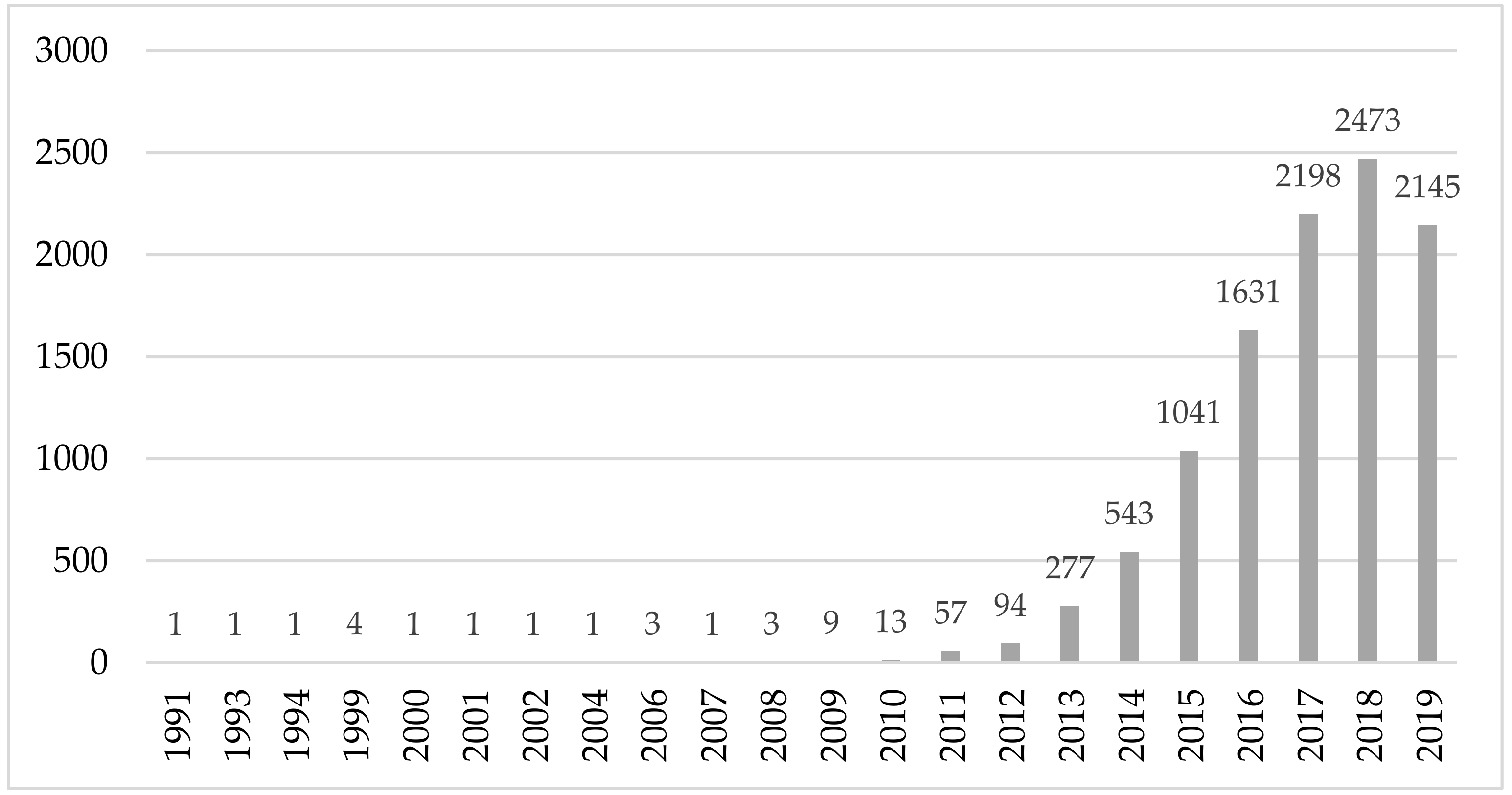


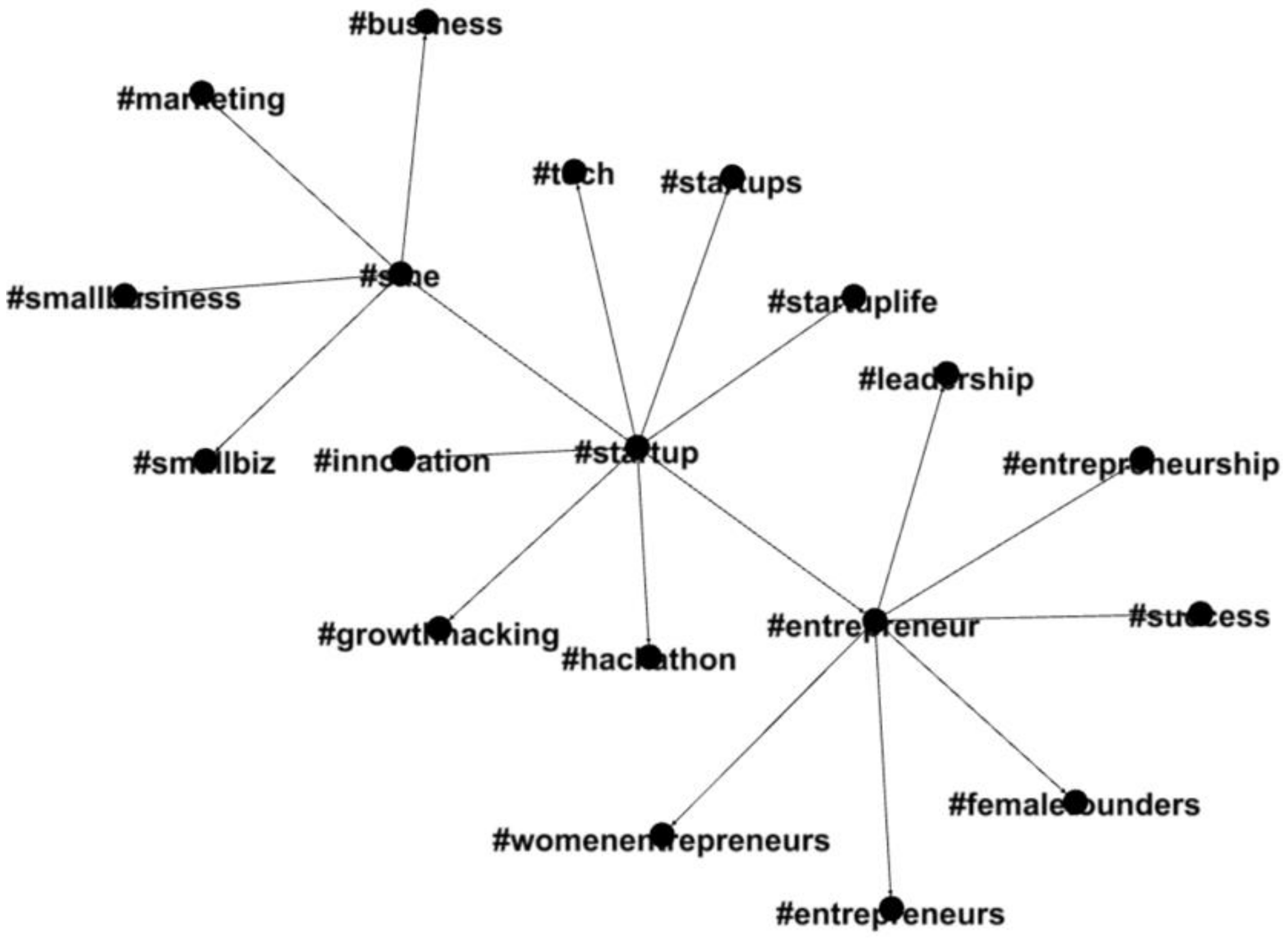
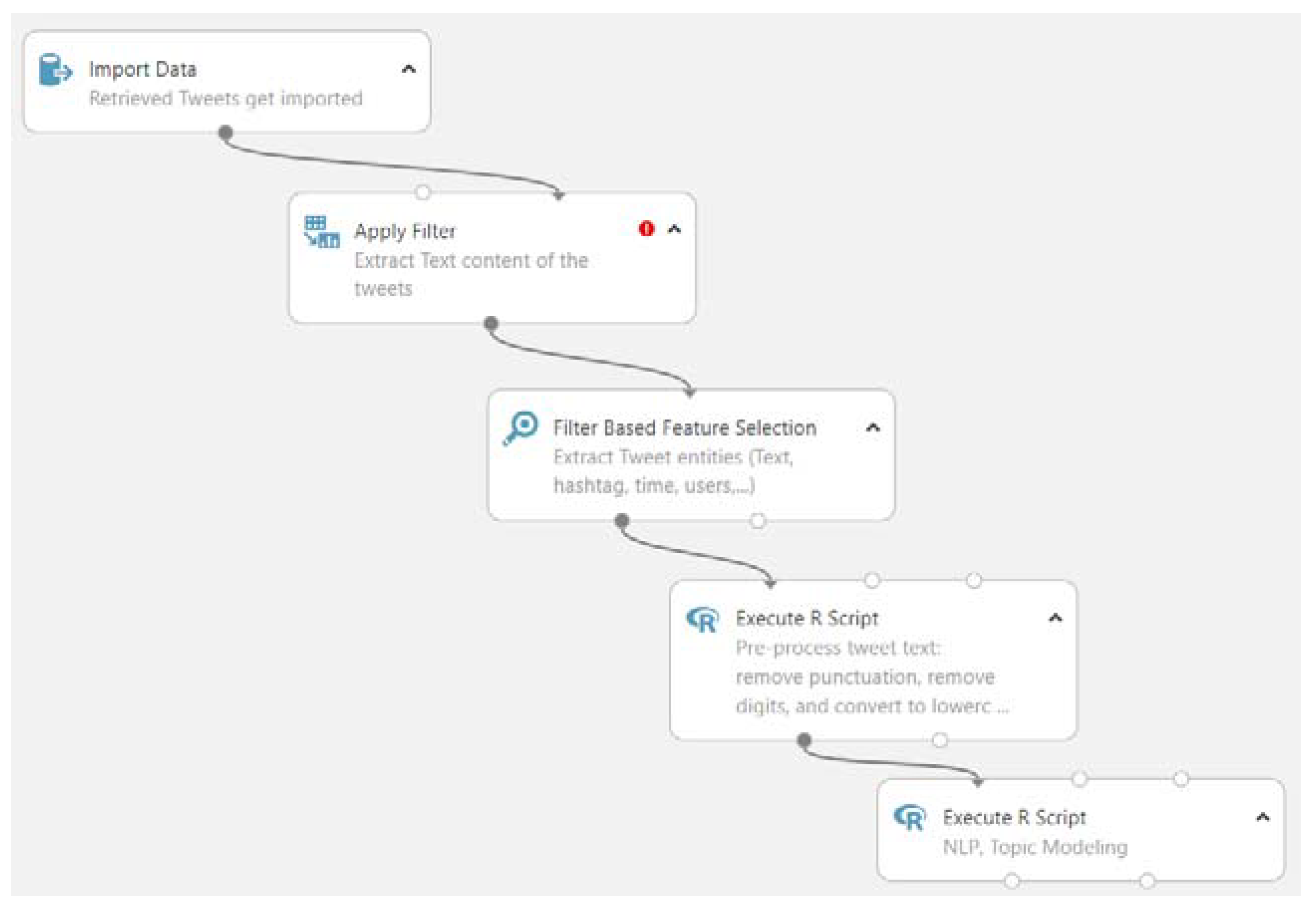
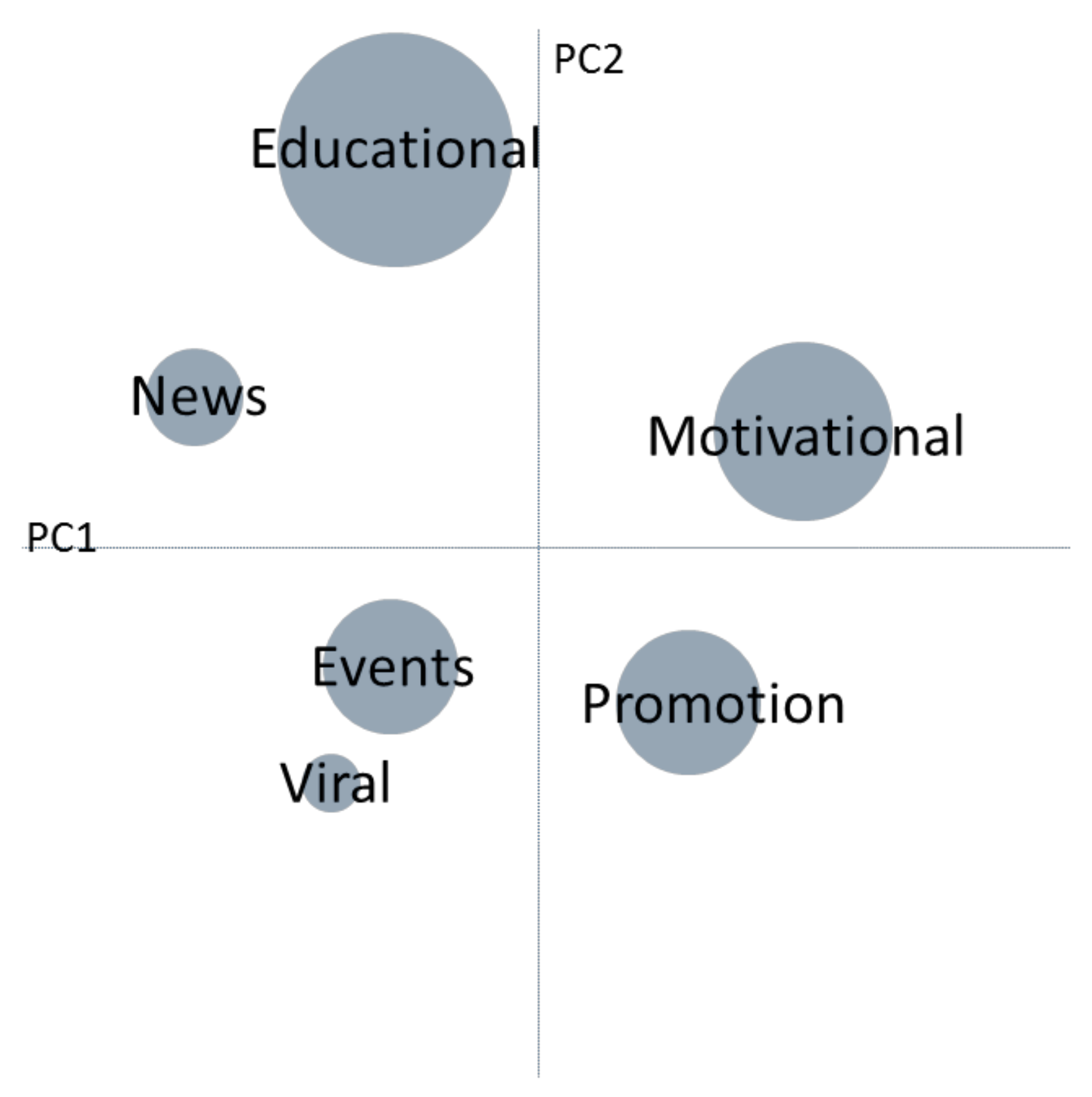
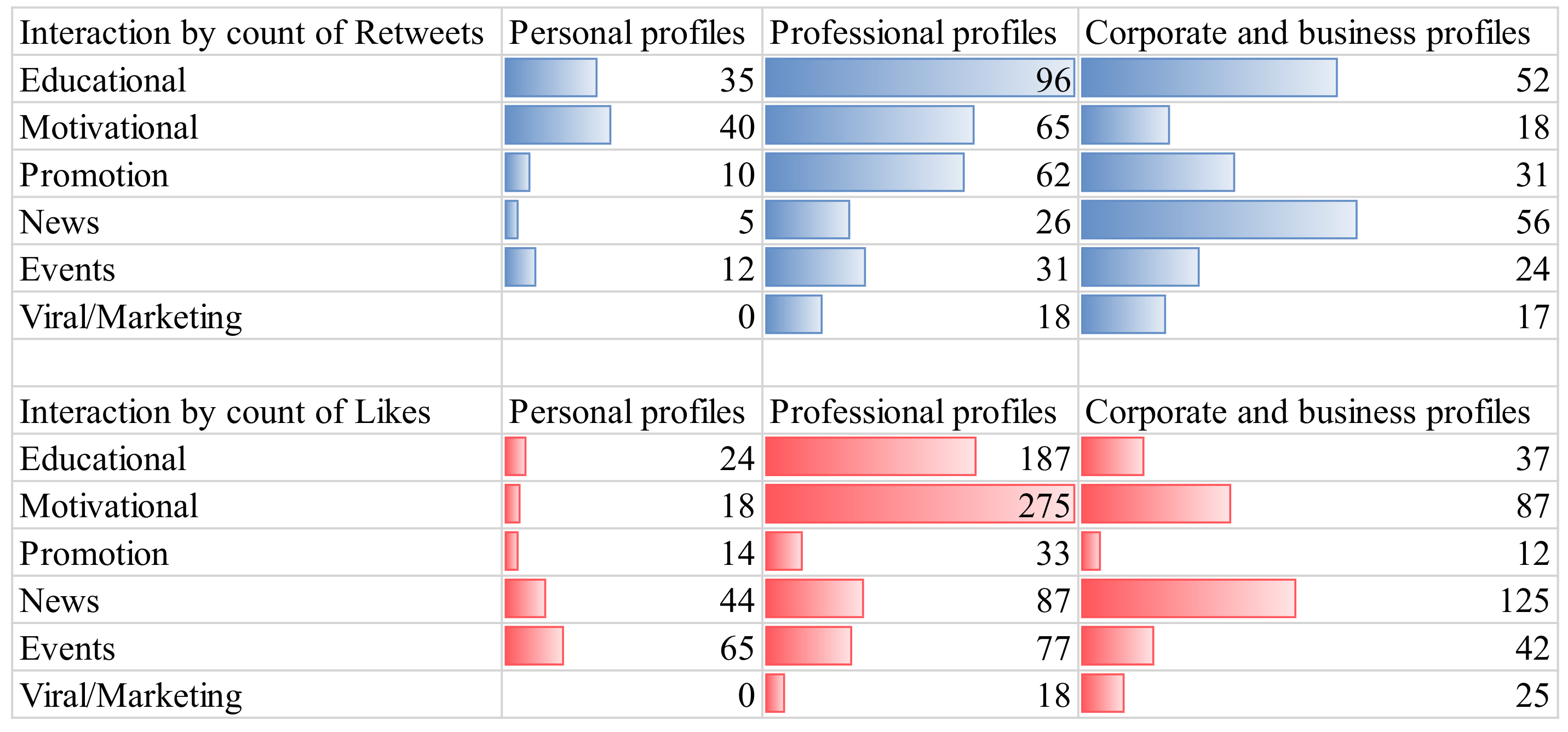
| User | Body | Interaction | Hashtags | URLs | Mentions | Followers Count | Following Count | Profile Description |
|---|---|---|---|---|---|---|---|---|
| @JonGarcia | Elevate your strategic approach. Master these & become unstoppable #success #wealth #startup #business #moneymaker | 1 | #success #wealth #startup #business #moneymaker | NO | NO | 17 | 36 | NO |
| @obinformatics | 1 reason startups fail is that they don’t have the resources at the beginning. Don’t be afraid to ask for help #startup #tip #resource #help | 0 | #startup #tip #resource #help | NO | NO | 10 | 73 | YES |
| @Ryan_EP | Need to summize performance of your #startup? ARR growth can be misleading, choose @salesforce’s strategy of booking. | 6 | #startup | NO | YES | 1324 | 2543 | NO |
| @AAINaggar | What’s #Cognitive #Tech? #AI #Robotics #BigData #defstar5 #Mpgvip #SMM #Startup #IoT #makeyourownlane #Marketing #Deeplearning #ML #M2M | 54 | #Cognitive #Tech #AI #Robotics #BigData #defstar5 #Mpgvip #SMM #Startup #IoT #makeyourownlane #Marketing #Deeplearning #ML #M2M | NO | NO | 532 | 1345 | YES |
| @CoffeeSpaceHQ | Fuelling the #startup community @techdayhq with good stuff. With @KERB_ and the delicious…Instagram.com/p/Ba39R5oBOP-/ | 5 | #startup | YES | YES | 312 | 645 | YES |
| @elliottldenham | #techday #london in full swing! Absolutely buzzing! #tech #startup | 16 | #techday #london #tech #startup | NO | NO | 159 | 867 | NO |
| @Abadesi | Great session yesterday @Google talking all things #startup and #Entrepreneurship #blackhistorymonthUK #PocTech | 20 | #startup #Entrepreneurship #blackhistorymonthUK #PocTech | NO | YES | 432 | 7312 | YES |
| @siyatechventure | Don’t Build a Startup, Build a Movment Medium.com/swlh/don’t-buil… #entrepreneur #startup #venture #growthhacking #contentmarketing #sales | 12 | #entrepreneur #startup #venture #growthhacking #contentmarketing #sales | NO | YES | 12 | 430 | YES |
| Model | Sum of Squares | df | Mean Square | F | Sig. |
|---|---|---|---|---|---|
| Regression | 9104.195 | 12 | 758.683 | 7.706 | 0.000 a |
| Residual | 15,259.466 | 155 | 98.448 | ||
| Total | 24,363.661 | 167 |
| Unstandardized Coefficients | Standardized Coefficients | Sig. | ||
|---|---|---|---|---|
| B | Std. Error | Beta | ||
| (Constant) | 10.836 | 1.338 | 0.000 | |
| ed-prof | 13.830 | 3.568 | 0.259 | 0.000 |
| mot-pers | 10.527 | 3.277 | 0.216 | 0.002 |
| mot-prof | 20.709 | 3.277 | 0.425 | 0.000 |
| new-corp | 8.275 | 3.568 | 0.155 | 0.022 |
© 2020 by the author. Licensee MDPI, Basel, Switzerland. This article is an open access article distributed under the terms and conditions of the Creative Commons Attribution (CC BY) license (http://creativecommons.org/licenses/by/4.0/).
Share and Cite
Hajikhani, A. Impact of Entrepreneurial Ecosystem Discussions in Smart Cities: Comprehensive Assessment of Social Media Data. Smart Cities 2020, 3, 112-137. https://doi.org/10.3390/smartcities3010007
Hajikhani A. Impact of Entrepreneurial Ecosystem Discussions in Smart Cities: Comprehensive Assessment of Social Media Data. Smart Cities. 2020; 3(1):112-137. https://doi.org/10.3390/smartcities3010007
Chicago/Turabian StyleHajikhani, Arash. 2020. "Impact of Entrepreneurial Ecosystem Discussions in Smart Cities: Comprehensive Assessment of Social Media Data" Smart Cities 3, no. 1: 112-137. https://doi.org/10.3390/smartcities3010007
APA StyleHajikhani, A. (2020). Impact of Entrepreneurial Ecosystem Discussions in Smart Cities: Comprehensive Assessment of Social Media Data. Smart Cities, 3(1), 112-137. https://doi.org/10.3390/smartcities3010007





